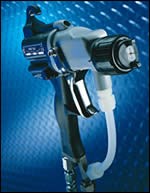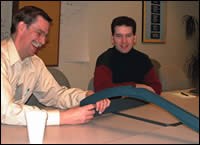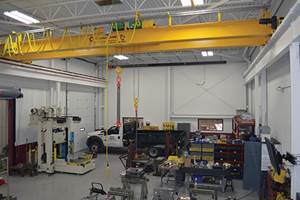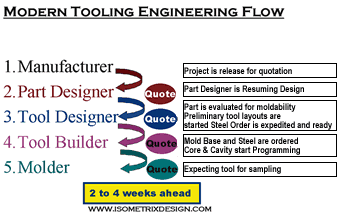Employ Design for Manufacturability to Meet Project Challenges
Bringing teams on board early results in met deadlines and budgets.
In a market concerned with lower costs, faster speed to market, less downtime and no scrap, molders, moldmakers and designers must act together in designing for manufacturability.
Designing for manufacturability ensures quality part output, minimizes tooling costs, optimizes material selection, increases processing speeds and generally leads to better, more cost-effective parts. OEMs that engage their molders and moldmakers in up-front collaboration realize a distinct competitive advantage in the marketplace. Molders and moldmakers who participate see fewer revisions, happier customers and more growth opportunities.
The typical process, when done right, begins with the OEM calling on their molder as soon as a new product is in the works. The molder then works with the OEM’s design team and gets the part to approximately 60 to 90 percent completion, at which point the moldmaker is brought into the conversation by the molder. From there, the group discusses cams, lifts, cooling, part ejection and other mold-related details that may determine final changes before the design is finalized.
In some cases, the OEM brings in the moldmaker and the molder is left out. By missing this important connection, opportunities are lost for optimal part design and the most successful molding project. The part design team should be looked at as a three-legged stool, and if all three legs are not present, the outcome is less than desirable.
Because the molder typically brings the moldmaker into the equation, the relationship between the two companies is critical. As a moldmaker, you should seek out molders who are willing to use their resources, engineers and ideas in working with the customer up-front. Conversely, molders should seek moldmaking partners who are willing to invest their resources early in the process to make a part and a mold that is repeatable and will make quality parts with little to no adjustments needed.
Two OEMs—Graco and Scotsman Ice Systems—have seen the value of early design help firsthand. They both faced major product launches with tight turnaround times. They turned to Donnelly Custom Manufacturing Company—an industry partner dedicated to short-run manufacturing in the custom injection molding marketplace—to bring engineering services to the table (the tool shops, material providers, assemblers and other support areas) and to help them achieve compressed leadtimes, fast changeovers and global supply chain management.
Establishing these integrated engineering teams reduced the number of molds, parts and secondary operations required—resulting in significant improvements in time-to-market as well as product performance, reliability and cost. In both of these cases, early design engineering paid off.
Graco’s Challenge
Graco is a leading manufacturer of a wide range of fluid handling equipment including spray finishing and paint circulation, lubrication, sealant and adhesives, processing, as well as power application equipment for the contractor industry and OEM customers.
In 2006, Graco faced one of the most engineering-intensive projects it had ever seen: a $1.9 million mold build project with time constraints and 40 new tools involving 50-plus parts. The project began without a clearly defined design, which would have made tooling changes, tweaks and adjustments inevitable.
Graco, which had six engineers who worked on this project, called on Donnelly because of its previous short-run, multi-part project management experience and a longstanding relationship that began in the mid-1980s. Donnelly’s engineering team worked with Graco and coordinated activities with toolmakers—one in China and five sources domestically. The engineers also worked with prototype shops and material companies to keep the process moving.
The team’s first project was to make the product more moldable. One part involved considerable moldmaker involvement to replace a conventional mold design that used slides in exchange for an A-side cavity lift. The mold base size needed to accommodate slide action and would have driven it to run on a larger press, resulting in a higher press rate for the OEM. Using an internal lift accommodated a smaller mold and therefore smaller machine and lower press rate. This significant modification in mold design was a direct result of the primary moldmaker’s (MSI Mold Builders, Cedar Rapids, IA) involvement before product design was finalized.
Early involvement of the team also helped in material selection. Graco wanted to convert one part from metal to plastic because the metal was too complicated, costly and heavy. Graco relied on Donnelly to recommend a material that would provide the same strength the metal part had. The material supplier brought in determined the choice that provided the strength needed for the application was a 50 percent long, glass fiber-filled polypropylene.
In the end, designing for manufacturability improved the output and minimized the tooling changes that were necessary. This involvement helped get the tools delivered within the set time frame and Graco was satisfied with the timing and performance of the molds.
Scotsman’s Challenge
Scotsman is a leading ice technology company. The company’s challenge was the introduction of its ice-maker product line called the Prodigy, the next generation of smart, energy efficient ice machines. The project required the design, management and manufacture of 40 new molds.
Roger Kunkel, Donnelly’s project engineer, was assigned to Scotsman and served as an integral part of the engineering team. He ensured the design was usable, which required continuous collaboration with the moldmaker to determine what could and could not be done. Kunkel’s intimate knowledge of Scotsman’s product line based on 15 years of working closely together enabled him to assist with product design and ensure the application and cosmetic requirements of the parts were met.
By analyzing mold materials for the water header—the most complicated part—a tooling issue was identified. They were unable to get adequate water into the tool to cool the part as needed to prevent warping. Instead of making the mold core out of standard tool steel, they used a high thermally conductive, mold building material. This material choice allowed for adequate cooling for cycle time improvement and eliminated the part distortion concerns. Because of a close relationship with the moldmaker, they were able to help anticipate tooling issues such as gating, cooling, hot spot elimination and meet tolerance requirements as well.
Up-front collaboration with the molder, moldmaker and OEM allowed Scotsman to meet its very aggressive timeline with no production surprises. The Prodigy launched on time and on budget with cost savings realized in smarter product design. The product has since won the 2007 Kitchen Innovations Award from the National Restaurant Association and the Best Equipment Award at the Western Foodservice & Hospitality Expo.
“Up-front collaboration was essential to engineering parts that were easily manufactured and to the on-time delivery of the Prodigy to the marketplace,” says Alex Harvey, Scotsman’s director of procurement and process quality.
Conclusion
OEMs and their molding and moldmaking partners need to start the communication process sooner to realize cost-saving opportunities by simplifying part design. Providing molders and moldmakers with a deeper understanding of their business and new products enables them to recommend changes that simplify the design while maintaining its functionality and aesthetic requirements.
Molders and moldmakers also can reduce an OEM’s project and product costs during the design phase by identifying multiple material alternatives. Having options allows the most suitable and effective material to be selected, and it isn’t always the first material considered.
Both Graco and Scotsman enlisted the help of a qualified outside industry partner dedicated to short-run manufacturing in the custom injection molding marketplace to bring in moldmakers and material suppliers at the beginning stages of product design, allowing both intensive projects to be completed on-time and successfully launched. The results included better mold design and parts, and, in the end, terrific products and satisfied customers.
Related Content
OEE Monitoring System Addresses Root Cause of Machine Downtime
Unique sensor and patent-pending algorithm of the Amper machine analytics system measures current draw to quickly and inexpensively inform manufacturers which machines are down and why.
Read MoreThe Critical Role of Management Representatives in ISO 9001
In ISO 9001 quality management systems, the Management Representative (MR) plays a crucial role. While the 2015 version of ISO 9001 no longer mandates this position, having a trusted management member serve as an MR remains vital for streamlining operations and maintaining quality standards.
Read MoreSteps for Determining Better Mold Prices
Improving your mold pricing requires a deeper understanding of your business.
Read MoreThe Trifecta of Competitive Toolmaking
Process, technology and people form the foundations of the business philosophy in place at Eifel Mold & Engineering.
Read MoreRead Next
The Key to Up-Front Mold Design
By involving the tool designer, builder and molder early in product development, you can reduce turnaround time by weeks or even months, shave weeks off the mold construction cycle and reduce costs by eliminating potential product design troubles.
Read MoreReasons to Use Fiber Lasers for Mold Cleaning
Fiber lasers offer a simplicity, speed, control and portability, minimizing mold cleaning risks.
Read MoreAre You a Moldmaker Considering 3D Printing? Consider the 3D Printing Workshop at NPE2024
Presentations will cover 3D printing for mold tooling, material innovation, product development, bridge production and full-scale, high-volume additive manufacturing.
Read More






















